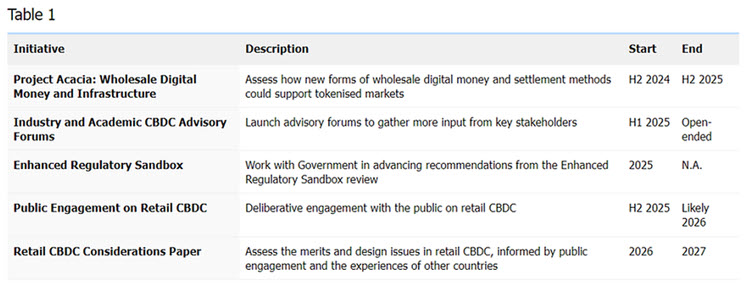At the Intersekt Fintech Conference in Melbourne today, the Reserve Bank of Australia (RBA) announced its strategic commitment to prioritize its work agenda on wholesale digital money and infrastructure, including a wholesale central bank digital currency (CBDC) over a retail CBDC. These efforts follow the RBA’s successful CBDC pilot in 2023 with a view to unlocking the potential efficiency benefits of tokenised assets and markets for the Australian economy.
Brad Jones, Assistant Governor (Financial System) of the RBA, spoke on financial innovation and the future of CBDC in Australia, coinciding with the RBA and the Treasury’s first-ever joint paper released today on CBDC and the future of digital money in Australia.
Mr Jones said,
the RBA is making a strategic commitment to prioritise its work agenda on wholesale digital money and infrastructure – including wholesale CBDC – rather than retail CBDC.
According to Jones, the RBA assessed the potential benefits as more promising, and the challenges less problematic, for a wholesale CBDC compared to a retail CBDC.
Unlike a retail CBDC that would be issued for use by the public, a wholesale CBDC would, according to Mr Jones:
represent more an evolution than revolution in our monetary arrangements.
Mr Jones said the RBA is committing to a three-year applied research program on the future of digital money in Australia, of which the most immediate priority is to launch a new project with industry on wholesale CBDC and tokenised commercial bank deposits.
Roadmap
While the RBA will focus its resources on a wholesale CBDC, it appears that a retail CBDC is not off the table depending on global developments. The following table sets out the key components of the three-year digital money work plan for the RBA and Treasury:

According to this work plan:
- Top priority is to launch the public phase of Project Acacia, which builds on the lessons from RBA’s CBDC pilot last yearby focusing on opportunities to uplift the efficiency, transparency and resilience of wholesale markets through tokenised money and new settlement infrastructure. In October, the RBA will publish a consultation paper inviting industry engagement.
- To launch industry and academic CBDC advisory forums in the first half of 2025, covering both retail and wholesale CBDC issues.
- A third initiative, to begin in 2025, will involve supporting reforms to a existing regulatory sandbox – which provides unlicensed businesses scope to test new financial products and services for a limited time – for financial innovation, including digital money and infrastructure.
- A fourth initiative commencing later next year may involve a series of ‘deliberative workshops’ on retail CBDC with the Australian community. Focus groups could include a broad cross-section of the population as well as minority groups that can be under-represented in public policy consultations.
- Finally, the RBA and Treasury are committed to reassessing the merits of a retail CBDC over time, with a follow up paper to be published in 2027.
Retail CBDC considerations
As mentioned above, Mr Jones said RBA considers the potential benefits of a retail CBDC generally appear modest or uncertain at the present time, relative to the challenges it would introduce.
He followed that most of the arguments made internationally in support of a retail CBDC (e.g. in relation to efficiency and cost, financial inclusion, bank runs, monetary policy implementation and transmission) reflect issues that are either of limited relevance to Australia, or where it is not obvious that a retail CBDC would best address them.
Wholesale CBDC considerations
Mr Jones acknowledged the context in which the RBA considers wholesale CBDC is fundamentally different to retail CBDC because central banks already have a long history of issuing digital money to financial institutions in support of their monetary and financial stability objectives.
Like Exchange Settlement (ES) balances, a wholesale CBDC would be issued to eligible financial institutions and serve as the ultimate safe asset in the settlement of wholesale market transactions. What is new is that it could exist on different types of ledgers (centralised or decentralised) possibly alongside tokenised assets, and offer greater functionality than today’s ES balances. This could support asset settlement and other wholesale payments in new ways.
Wholesale CBDCs may play a role to uplift the functioning of wholesale markets, including by:
- Reducing counterparty and operational risks, and improving capital efficiency, by freeing up collateral
- Increasing informational transparency and auditability
- Increasing liquidity and the ability to transact
- Reducing intermediary and compliance costs
Tokenisation
Mr Jones also mentioned that the RBA’s exploratory research has seen the potential role that tokenisation might play in a future financial system:
Tokens could be stored, traded and transferred on either centralised or decentralised programmable platforms. The programmability of tokens via smart contracts, and the ability to free up collateral and reduce counterparty risk by atomically exchanging money and assets on the same ledger, have been of particular interest in experimental research.
Conclusions
According to the RBA, the introduction of a wholesale CBDC may require supporting legislation depending on the design and scope of use. The RBA and Treasury have expressed reluctance to compromise any CBDC design features in an effort to give it legal status under current legislative or regulatory frameworks. Instead, they believe it is preferable to identify the features of a CBDC that are most desirable from a policy perspective, and then make any necessary enabling amendments to applicable legislation.
While the RBA’s plan to focus on a wholesale CBDC puts a retail CBDC on the backburner for now, a wholesale CBDC could still unlock significant opportunities for the private sector in relation to tokenised assets and stablecoins. Reuters reported that around 134 countries representing 98% of the global economy are now exploring digital versions of their currencies, according to a recent research by a US think-tank. Following the RBA and the Treasury’s announcement, Australia will follow in the footsteps of other major economies such as the US and China in what might be the biggest financial innovation in decades.









